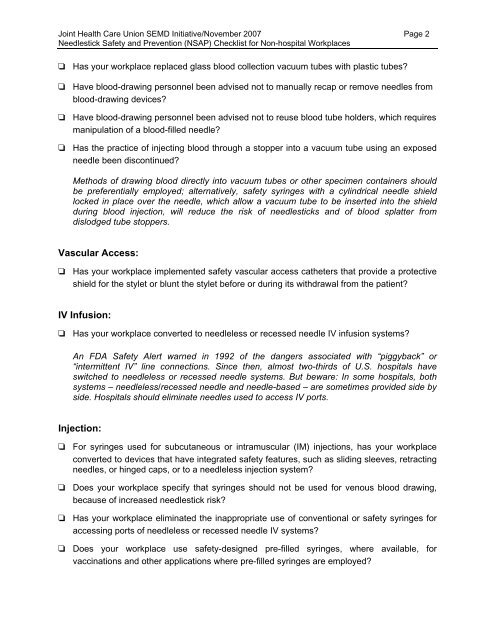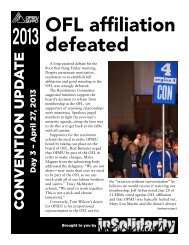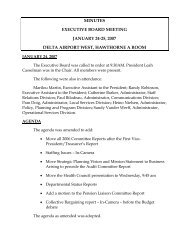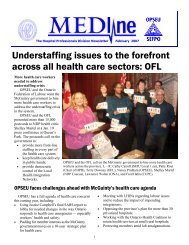Needlestick Safety and Prevention (NSAP) Checklist For ... - OPSEU
Needlestick Safety and Prevention (NSAP) Checklist For ... - OPSEU
Needlestick Safety and Prevention (NSAP) Checklist For ... - OPSEU
Create successful ePaper yourself
Turn your PDF publications into a flip-book with our unique Google optimized e-Paper software.
Joint Health Care Union SEMD Initiative/November 2007 Page 2<strong>Needlestick</strong> <strong>Safety</strong> <strong>and</strong> <strong>Prevention</strong> (<strong>NSAP</strong>) <strong>Checklist</strong> for Non-hospital Workplaces❏ Has your workplace replaced glass blood collection vacuum tubes with plastic tubes?❏ Have blood-drawing personnel been advised not to manually recap or remove needles fromblood-drawing devices?❏ Have blood-drawing personnel been advised not to reuse blood tube holders, which requiresmanipulation of a blood-filled needle?❏ Has the practice of injecting blood through a stopper into a vacuum tube using an exposedneedle been discontinued?Methods of drawing blood directly into vacuum tubes or other specimen containers shouldbe preferentially employed; alternatively, safety syringes with a cylindrical needle shieldlocked in place over the needle, which allow a vacuum tube to be inserted into the shieldduring blood injection, will reduce the risk of needlesticks <strong>and</strong> of blood splatter fromdislodged tube stoppers.Vascular Access:❏ Has your workplace implemented safety vascular access catheters that provide a protectiveshield for the stylet or blunt the stylet before or during its withdrawal from the patient?IV Infusion:❏ Has your workplace converted to needleless or recessed needle IV infusion systems?An FDA <strong>Safety</strong> Alert warned in 1992 of the dangers associated with “piggyback” or“intermittent IV” line connections. Since then, almost two-thirds of U.S. hospitals haveswitched to needleless or recessed needle systems. But beware: In some hospitals, bothsystems – needleless/recessed needle <strong>and</strong> needle-based – are sometimes provided side byside. Hospitals should eliminate needles used to access IV ports.Injection:❏ <strong>For</strong> syringes used for subcutaneous or intramuscular (IM) injections, has your workplaceconverted to devices that have integrated safety features, such as sliding sleeves, retractingneedles, or hinged caps, or to a needleless injection system?❏ Does your workplace specify that syringes should not be used for venous blood drawing,because of increased needlestick risk?❏ Has your workplace eliminated the inappropriate use of conventional or safety syringes foraccessing ports of needleless or recessed needle IV systems?❏ Does your workplace use safety-designed pre-filled syringes, where available, forvaccinations <strong>and</strong> other applications where pre-filled syringes are employed?
















